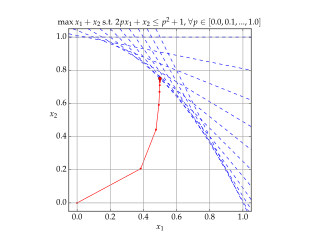Quadratic programming (QP) is the process of solving certain mathematical optimization problems involving quadratic functions. Specifically, one seeks to optimize a multivariate quadratic function subject to linear constraints on the variables. Quadratic programming is a type of nonlinear programming.

Mathematical optimization or mathematical programming is the selection of a best element, with regard to some criterion, from some set of available alternatives. It is generally divided into two subfields: discrete optimization and continuous optimization. Optimization problems of sorts arise in all quantitative disciplines from computer science and engineering to operations research and economics, and the development of solution methods has been of interest in mathematics for centuries.
In mathematics, nonlinear programming (NLP) is the process of solving an optimization problem where some of the constraints or the objective function are nonlinear. An optimization problem is one of calculation of the extrema of an objective function over a set of unknown real variables and conditional to the satisfaction of a system of equalities and inequalities, collectively termed constraints. It is the sub-field of mathematical optimization that deals with problems that are not linear.
In mathematics, a variational inequality is an inequality involving a functional, which has to be solved for all possible values of a given variable, belonging usually to a convex set. The mathematical theory of variational inequalities was initially developed to deal with equilibrium problems, precisely the Signorini problem: in that model problem, the functional involved was obtained as the first variation of the involved potential energy. Therefore, it has a variational origin, recalled by the name of the general abstract problem. The applicability of the theory has since been expanded to include problems from economics, finance, optimization and game theory.
In mathematical optimization theory, the linear complementarity problem (LCP) arises frequently in computational mechanics and encompasses the well-known quadratic programming as a special case. It was proposed by Cottle and Dantzig in 1968.
In mathematical optimization, the active-set method is an algorithm used to identify the active constraints in a set of inequality constraints. The active constraints are then expressed as equality constraints, thereby transforming an inequality-constrained problem into a simpler equality-constrained subproblem.

Interior-point methods are a certain class of algorithms that solve linear and nonlinear convex optimization problems.
Convex optimization is a subfield of mathematical optimization that studies the problem of minimizing convex functions over convex sets. Many classes of convex optimization problems admit polynomial-time algorithms, whereas mathematical optimization is in general NP-hard.
In mathematics, a Q-matrix is a square matrix whose associated linear complementarity problem LCP(M,q) has a solution for every vector q.
In mathematical optimization and related fields, relaxation is a modeling strategy. A relaxation is an approximation of a difficult problem by a nearby problem that is easier to solve. A solution of the relaxed problem provides information about the original problem.
Mixed Complementarity Problem (MCP) is a problem formulation in mathematical programming. Many well-known problem types are special cases of, or may be reduced to MCP. It is a generalization of nonlinear complementarity problem (NCP).
The TOMLAB Optimization Environment is a modeling platform for solving applied optimization problems in MATLAB.
Mathematical programming with equilibrium constraints (MPEC) is the study of constrained optimization problems where the constraints include variational inequalities or complementarities. MPEC is related to the Stackelberg game.
In mathematical optimization, Lemke's algorithm is a procedure for solving linear complementarity problems, and more generally mixed linear complementarity problems. It is named after Carlton E. Lemke.
In applied mathematics, a nonlinear complementarity problem (NCP) with respect to a mapping ƒ : Rn → Rn, denoted by NCPƒ, is to find a vector x ∈ Rn such that

In mathematical optimization, the criss-cross algorithm is any of a family of algorithms for linear programming. Variants of the criss-cross algorithm also solve more general problems with linear inequality constraints and nonlinear objective functions; there are criss-cross algorithms for linear-fractional programming problems, quadratic-programming problems, and linear complementarity problems.

SICONOS is an Open Source scientific software primarily targeted at modeling and simulating non-smooth dynamical systems (NSDS):
Algebraic modeling languages like AIMMS, AMPL, GAMS, MPL and others have been developed to facilitate the description of a problem in mathematical terms and to link the abstract formulation with data-management systems on the one hand and appropriate algorithms for solution on the other. Robust algorithms and modeling language interfaces have been developed for a large variety of mathematical programming problems such as linear programs (LPs), nonlinear programs (NPs), Mixed Integer Programs (MIPs), mixed complementarity programs (MCPs) and others. Researchers are constantly updating the types of problems and algorithms that they wish to use to model in specific domain applications.

Richard W. Cottle is an American mathematician. He was a professor of Management Science and Engineering at Stanford University, starting as an Acting Assistant Professor of Industrial Engineering in 1966 and retiring in 2005. He is notable for his work on mathematical programming/optimization, “Nonlinear programs”, the proposal of the linear complementarity problem, and the general field of operations research.




